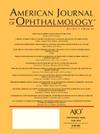Corneal Sensory Changes and Nerve Plexus Abnormalities in Chronic Neuropathic Ocular Pain and Dry Eye Postrefractive Surgery
IF 4.1
1区 医学
Q1 OPHTHALMOLOGY
引用次数: 0
Abstract
Purpose
Chronic neuropathic ocular pain (NOP) can develop alongside chronic dry eye (DE) post–laser-assisted in-situ keratomileusis (LASIK), yet its specific characteristics remain poorly understood. This study aims to compare the clinical characteristics of patients who developed both DE and NOP after LASIK to those with only DE and to asymptomatic LASIK patients, to facilitate the diagnosis of NOP.
Methods
Prospective, cross-sectional “case-control” comparison study. An 89-subject post-LASIK study comprised 3 groups: 34 patients developing NOP and DE (NOP-DE group), 25 patients developing only DE (DE group), and 30 asymptomatic subjects (control group). Assessments included clinical history and symptom questionnaires (OSDI, mSIDEQ, NRS, WFPRS), anxiety and depression evaluation (HADS), tear film stability (osmolarity and TBUT) and production (Schirmer), and ocular surface integrity. Corneal mechanical and thermal sensitivity thresholds were measured using Belmonte's noncontact esthesiometer, whereas tactile sensitivity threshold was assessed pre-/post-topical anesthesia using the Cochet-Bonnet esthesiometer. In vivo confocal microscopy (IVCM) was used to evaluate the sub-basal nerve plexus characteristics and dendritic cell density in the central cornea. Group comparisons and correlations were conducted.
Results
Compared with DE group, patients in the NOP-DE group exhibited significantly more DE symptoms with mSIDEQ (P = .019) higher level of pain with NRS and WFPRS, increased use of ocular lubrication (P = .003), greater frequency of patients with pathological results on anxiety and depression questionnaires (P < .001), and a higher prevalence of central sensitization syndromes (P < .001). Additionally, NOP-DE patients demonstrated higher tactile corneal sensitivity post-topical anesthesia (P = .002). IVCM revealed lower nerve density (P = .049) and higher microneuroma density (P = .008) in the sub-basal nerve plexus of NOP-DE patients compared to DE patients without NOP (P = .008). Most nerve metrics correlated moderately to strongly with clinical parameters.
Conclusions
Persistent high corneal tactile sensitivity postanesthesia, reduced nerve density, and increased microneuroma density in the central cornea may serve as diagnostic indicators for confirming NOP in patients experiencing chronic DE post-LASIK. These findings underscore the potential utility of incorporating these measures into clinical assessments to improve diagnostic accuracy and guide management strategies in this patient population.
屈光术后慢性神经性眼痛和干眼的角膜感觉改变和神经丛异常。
目的:慢性神经性眼痛(NOP)可伴随激光辅助原位角膜磨除术(LASIK)后的慢性干眼(DE)发生,但其具体特征尚不清楚。本研究旨在比较LASIK术后同时发生DE和NOP的患者与仅发生DE和无症状LASIK患者的临床特征,以方便NOP的诊断。方法前瞻性、横断面“病例-对照”比较研究。一项89名受试者的lasik术后研究分为三组:34名患者出现NOP和DE (NOP-DE组),25名患者仅出现DE (DE组),30名无症状患者(对照组)。评估包括临床病史和症状问卷(OSDI, mSIDEQ, NRS, WFPRS),焦虑和抑郁评估(HADS),泪膜稳定性(渗透压和TBUT)和生成(Schirmer),以及眼表完整性。使用Belmonte非接触式感受器测量角膜的机械和热敏感阈值,而使用Cochet-Bonnet感受器评估表面麻醉前后的触觉敏感阈值。采用体内共聚焦显微镜(IVCM)观察角膜中央基底下神经丛特征和树突状细胞密度。进行组间比较和相关性分析。结果与DE组相比,NOP-DE组患者mSIDEQ症状明显增加(p=0.019), NRS和WFPRS疼痛程度更高,眼部润滑使用增加(p=0.003),焦虑和抑郁问卷病理结果的患者频率更高(p<0.001),中枢致敏综合征患病率更高(p<0.001)。此外,表面麻醉后,NOP-DE患者表现出更高的角膜触觉敏感性(p=0.002)。IVCM显示,与没有NOP的DE患者相比,NOP-DE患者基底下神经丛神经密度较低(p=0.049),微神经瘤密度较高(p=0.008)。大多数神经指标与临床参数有中等到强烈的相关性。结论麻醉后角膜触觉敏感性持续增高,角膜中央神经密度降低,微神经瘤密度增高,可作为lasik术后慢性DE患者NOP的诊断指标。这些发现强调了将这些措施纳入临床评估以提高诊断准确性和指导该患者群体的管理策略的潜在效用。
本文章由计算机程序翻译,如有差异,请以英文原文为准。
求助全文
约1分钟内获得全文
求助全文
来源期刊
CiteScore
9.20
自引率
7.10%
发文量
406
审稿时长
36 days
期刊介绍:
The American Journal of Ophthalmology is a peer-reviewed, scientific publication that welcomes the submission of original, previously unpublished manuscripts directed to ophthalmologists and visual science specialists describing clinical investigations, clinical observations, and clinically relevant laboratory investigations. Published monthly since 1884, the full text of the American Journal of Ophthalmology and supplementary material are also presented online at www.AJO.com and on ScienceDirect.
The American Journal of Ophthalmology publishes Full-Length Articles, Perspectives, Editorials, Correspondences, Books Reports and Announcements. Brief Reports and Case Reports are no longer published. We recommend submitting Brief Reports and Case Reports to our companion publication, the American Journal of Ophthalmology Case Reports.
Manuscripts are accepted with the understanding that they have not been and will not be published elsewhere substantially in any format, and that there are no ethical problems with the content or data collection. Authors may be requested to produce the data upon which the manuscript is based and to answer expeditiously any questions about the manuscript or its authors.

 求助内容:
求助内容: 应助结果提醒方式:
应助结果提醒方式:


